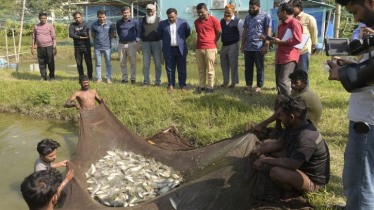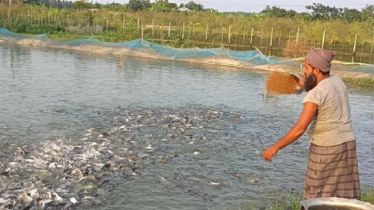
Fish farmers across Bangladesh are being advised to strengthen pond management practices as several seasonal diseases continue to threaten aquaculture production during winter, summer and the monsoon months. Experts warn that bacterial and parasitic infections increase rapidly when water quality deteriorates, making early identification and preventive management essential for reducing fish mortality.
Gill worm disease remains one of the most common and destructive infections in local ponds. The disease is caused by the parasite Dactylogyrus, which attacks the gills and severely disrupts respiration. Infected fish display rapid breathing, pale body coloration, hemorrhaging in the gills, swelling and decay of gill tissues, and frequent jumping at the water surface. Mortality often occurs quickly. To prevent the disease, farmers are advised to reduce stocking density and apply lime at a rate of 1 kilogram per decimal every three months. Organic manure and supplementary feed should be used sparingly to prevent water quality deterioration. Affected fish should be treated with a salt bath at 200 ppm once a week for two weeks, or kept in a 50 ppm formalin solution for one hour before release.
Another major concern during the rainy and winter seasons is worm infestation, which commonly affects nursery and grow-out ponds. These parasites primarily attack the gills of Nile tilapia and feed on blood from gill veins and capillaries. Infected fish become restless, develop lesions on their bodies, suffer from respiratory distress and often float near pond banks. They rub their bodies against hard surfaces, become weak and may die if untreated. To prevent and control the outbreak, farmers are advised to remove snails from water bodies and apply Dipterex at 40 grams per decimal for 1 meter water depth, administered twice at seven-day intervals. A solution prepared by mixing 1 milliliter of formalin in 3.5 liters of water can be used to dip infected fish for 5 to 10 minutes.
Ulcer disease continues to affect around 32 fish species in Bangladesh, posing a significant economic threat to small and commercial farmers. The disease originates from fungal infection caused by Aphanomyces, followed by secondary bacterial invasion. Small red spots appear on the fish body, which progress into deep wounds accompanied by tissue decay. In severe cases, eye damage, foul odor from infected areas, refusal to feed, pus formation, and loss of balance are observed. Advanced infections may cause tail and fin rot, leading to rapid mortality. Preventive measures include drying the pond bottom during the dry season and applying 1 kilogram of lime mixed with 1 kilogram of salt per decimal at the beginning of winter. Fry should be disinfected by bathing them in 2–3% salt solution before stocking. Farmers are advised to limit the use of organic fertilizers, dry nets in sunlight before reuse, and maintain strict hygiene. For treatment, 60–100 milligrams of terramycin or 1 gram of chloramphenicol should be mixed with each kilogram of feed for 7 to 10 consecutive days. Infected fish can be bathed in 5 ppm potassium permanganate solution for one hour or in 1 ppm copper sulphate solution for 10–15 minutes.
Aquaculture specialists emphasize that improved pond management, early detection of symptoms and timely treatment can significantly reduce fish losses, ensuring better production and sustainability for farmers across the country.





